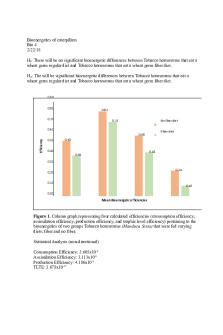Lubrent Hornwormlab - Hornworm lab PDF

| Title | Lubrent Hornwormlab - Hornworm lab |
|---|---|
| Course | Ecology |
| Institution | Rowan University |
| Pages | 2 |
| File Size | 113.5 KB |
| File Type | |
| Total Downloads | 82 |
| Total Views | 128 |
Summary
Hornworm lab...
Description
Bioenergetics of caterpillars Bio 4 2/22/18 H0: There will be no significant bioenergetic differences between Tobacco hornworms that eat a wheat germ regular diet and Tobacco hornworms that eat a wheat germ fiber diet. HA: The will be significant bioenergetic differences between Tobacco hornworms that eat a wheat germ regular diet and Tobacco hornworms that eat a wheat germ fiber diet.
0.90 0.80
0.81
0.70
No fiber diet
0.71
0.60
Fiber diet
Efficiency
0.58 0.50
0.53
0.40
0.42 0.39
0.30 0.24
0.20 0.10
0.10 0.00
Mean Bioenergetic efficiencies
Figure 1. Column graph representing four calculated efficiencies (consumption efficiency, assimilation efficiency, production efficiency, and trophic level efficiency) pertaining to the bioenergetics of two groups Tobacco hornworms (Manduca Sexta) that were fed varying diets; fiber and no fiber. Statistical Analysis (non-directional) Consumption Efficiency: 3.605x10-6 Assimilation Efficiency: 3.113x10-5 Production Efficiency: 4.186x10-5 TLTE: 3.678x10-17
The statistical analysis presents a p-value less than 0.05 for each of the four efficiencies. With a p-value less than 0.05, we can reject the null and support the alternate hypothesis. Application Questions 7. If we had fed the control group more of a natural diet, the consumption efficiency would either remain the same or increase because the natural diet could possibly be more appetizing to the worms. Assimilation efficiency would also remain the same or slightly increase, because if a worm eats more food it will excrete more waste. The production efficiency would decrease because the mass of the worm would not be as large. Since the worms would not be eating this “super food diet,” they would not be receiving the large amounts of nutrients that can increase growth. Trophic level transfer efficiency would decrease slightly or remain the same because although production efficiency will decrease, consumption efficiency and assimilation frequency would be unchanged. 8. If the temperature would have been higher, all of the efficiencies would have increased. Consumption efficiency would increase slightly because of the warmer environment; the worms may be more inclined to eat. Assimilation efficiency would also increase because digestive function may be performing a little faster due to the increase in enzyme activity. Production efficiency would increase significantly due to increase enzyme activity as well. Since consumption efficiency, assimilation efficiency and production efficiency would all increase, trophic level transfer efficiency would also increase. 9. The high TLTE calculations could lead to the idea that the food chain length of this ecosystem could be longer than a normal terrestrial ecosystem and that it could support about 4-5 trophic levels. This high TLTE could lead scientists to understanding how large the hornworm population is and from this understand other populations.
10. One design flaw is confounding variables. The damp paper towel provided in the box with the worm may have caused the food to absorb the moisture and alter the mass of the remaining food. If the amount of food consumed was massed to be greater than the actual value, it would skew the data for all of the efficiencies. To redesign this experimental, I would either use a food that would absorb less moisture or decrease the size and dampness of the paper towel used in the container....
Similar Free PDFs

Lab 2 lab sheet - lab
- 6 Pages

Astronomy Lab - lab assistance
- 25 Pages

GFP LAB - lab
- 7 Pages

Lab 7 - Ochem lab
- 9 Pages

LAB Guide - lab
- 100 Pages

Final Lab Fridge - Lab
- 1 Pages

Lab 1 Physics - Lab
- 4 Pages

LAB 5 - Lab report
- 4 Pages

Protein digestion lab - Lab
- 3 Pages

Lab Forces Motion - lab
- 2 Pages

Lab 8 - lab report
- 6 Pages

TLC Lab Lab Report
- 4 Pages

Lab 3 - Lab assignment.
- 5 Pages

Lemonade Lab - Lab report
- 4 Pages

Walking lab 1 - lab
- 4 Pages
Popular Institutions
- Tinajero National High School - Annex
- Politeknik Caltex Riau
- Yokohama City University
- SGT University
- University of Al-Qadisiyah
- Divine Word College of Vigan
- Techniek College Rotterdam
- Universidade de Santiago
- Universiti Teknologi MARA Cawangan Johor Kampus Pasir Gudang
- Poltekkes Kemenkes Yogyakarta
- Baguio City National High School
- Colegio san marcos
- preparatoria uno
- Centro de Bachillerato Tecnológico Industrial y de Servicios No. 107
- Dalian Maritime University
- Quang Trung Secondary School
- Colegio Tecnológico en Informática
- Corporación Regional de Educación Superior
- Grupo CEDVA
- Dar Al Uloom University
- Centro de Estudios Preuniversitarios de la Universidad Nacional de Ingeniería
- 上智大学
- Aakash International School, Nuna Majara
- San Felipe Neri Catholic School
- Kang Chiao International School - New Taipei City
- Misamis Occidental National High School
- Institución Educativa Escuela Normal Juan Ladrilleros
- Kolehiyo ng Pantukan
- Batanes State College
- Instituto Continental
- Sekolah Menengah Kejuruan Kesehatan Kaltara (Tarakan)
- Colegio de La Inmaculada Concepcion - Cebu
